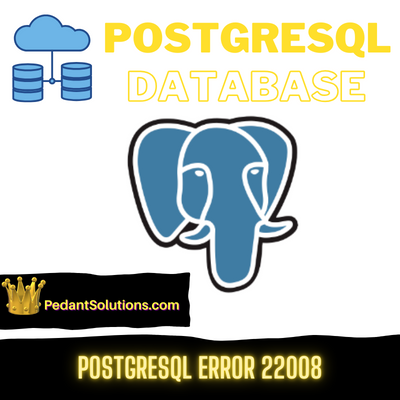Postgresql SQL error 22008 is specifically associated with time and date-related problems. In this article, we will unravel the common causes behind PostgreSQL SQL Error 22008 and provide insights into resolving these temporal challenges.

Common causes of Postgresql SQL error 22008
Datetime Format Mismatch
A prevalent cause of SQL Error 22008 is a mismatch between the expected datetime format and the actual format in your query. Ensure that the format of the datetime values aligns with the format expected by the database.
Example
INSERT INTO events (event_time) VALUES ('2023-12-18 15:30:00.1234');Invalid Date or Time Values
Attempting to insert or update with invalid date or time values can trigger Error 22008. Double-check that the date and time components fall within valid ranges.
Example
INSERT INTO appointments (appointment_date) VALUES ('2023-02-30');Timezone Issues
Timezone-related discrepancies may lead to SQL Error 22008. Ensure that your timestamps include the appropriate timezone information or that your database is configured to handle timezones correctly.
Example
SELECT * FROM log_entries WHERE log_timestamp > '2023-12-18 12:00:00' AND log_timestamp < '2023-12-18 15:00:00';Truncation of Time Components
If your query involves datetime truncation or rounding, ensure that the resulting values still conform to the expected datetime format. Truncating beyond the available precision may lead to errors.
Example
SELECT EXTRACT(HOUR FROM event_time) FROM events;Interval Arithmetic Issues
Performing interval arithmetic incorrectly can result in SQL Error 22008. Verify that you’re using the correct syntax and that the involved intervals are compatible.
Example
SELECT CURRENT_TIMESTAMP + INTERVAL '1 day';Using Date Functions Incorrectly
Misusing date functions or providing them with inappropriate arguments can cause this error. Review your usage of date functions to ensure correctness.
Example
SELECT DATE_PART('minute', '2023-12-18 15:30:00');Leap Year and Daylight Saving Time Challenges
Leap years and daylight saving time changes can introduce complexities. Be aware of potential pitfalls during these transitions.
Example
SELECT * FROM schedule WHERE start_time > '2023-03-12 02:00:00';Inspite of Postgresql SQL error 22008, here’s a list of some common PostgreSQL error codes, including but not limited to SQL Error 42601:
- SQL Error 42P01 – Undefined Table: This error occurs when a query references a table that does not exist in the database.
- SQL Error 42703 – Undefined Column: Triggered when a query attempts to use a column that is not present in the specified table.
- SQL Error 23505 – Unique Violation: Indicates that an attempt to insert or update a record violates a unique constraint.
- SQL Error 23502 – Not Null Violation: Occurs when an attempt is made to insert a null value into a column that has a NOT NULL constraint.
- SQL Error 42P02 – Undefined Parameter: This error is raised when using a parameter that is not defined in the context of the query.
- SQL Error 22001 – String Data Right Truncation: Signifies that a string or character data is too long for the specified column.
- SQL Error 42701 – Duplicate Column: Triggered when a table is created with duplicate column names.
- SQL Error 25P02 – In Failed SQL Transaction: Indicates a problem with transactions, often caused by trying to execute a query within a failed transaction.
- SQL Error 23000 – Integrity Constraint Violation: This error occurs when a foreign key constraint is violated during an insert or update operation.
- SQL Error 42602 – Invalid Syntax: Similar to SQL Error 42601, this error code is raised when there’s a syntax error in the SQL statement.
- SQL Error 28000 – Invalid Authorization Specification: Signifies authentication issues, such as providing incorrect login credentials.
- SQL Error 57014 – Canceling Statement Due to User Request: Occurs when a user cancels a running query or statement.
- SQL Error 22003 – Numeric Value Out Of Range: Indicates that a numeric value exceeds the valid range for its data type.
- SQL Error 08006 – Connection Failure: Raised when there is a problem establishing or maintaining a database connection.
- SQL Error 42P05 – Duplicate Table: Similar to SQL Error 42701, this error is raised when trying to create a table with a name that already exists.
- SQL Error 42601 – Syntax error: PostgreSQL uses error code 42601 to signify a syntax error within the SQL statement being executed. This error arises when PostgreSQL encounters a statement with a syntax it cannot recognize or correctly parse.
